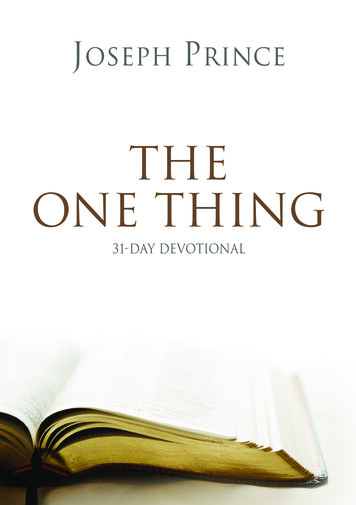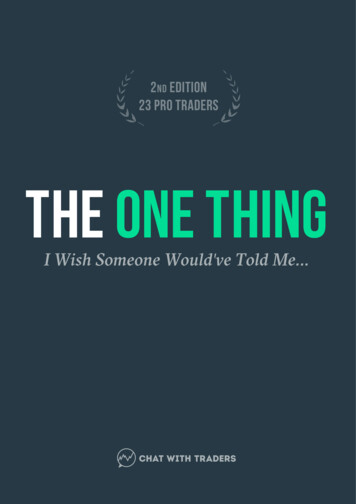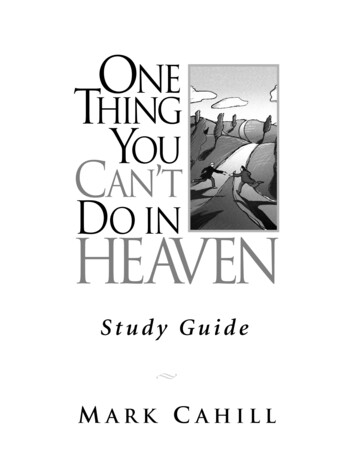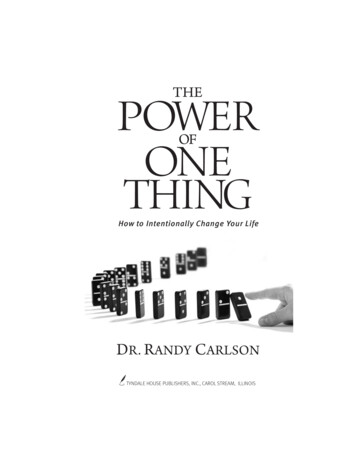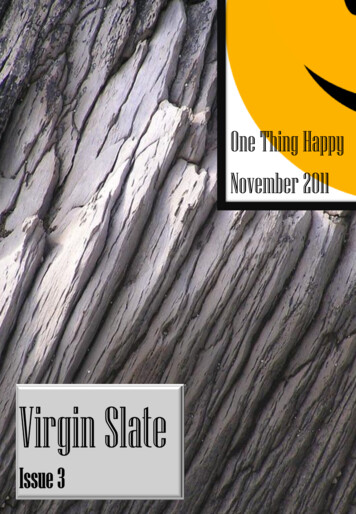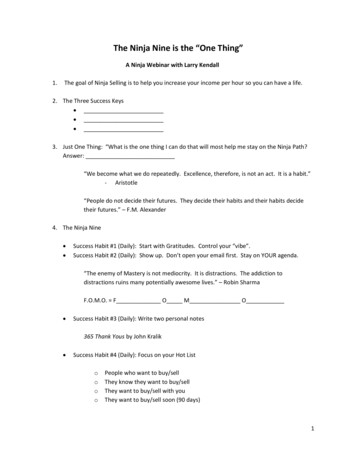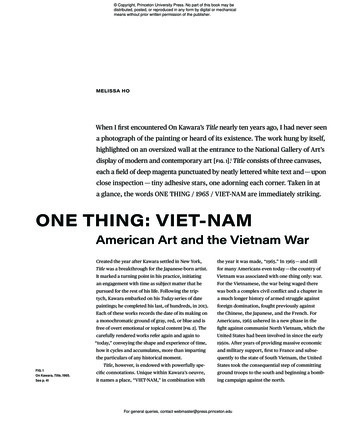
Transcription
Copyright, Princeton University Press. No part of this book may bedistributed, posted, or reproduced in any form by digital or mechanicalmeans without prior written permission of the publisher.MELISSA HOWhen I first encountered On Kawara’s Title nearly ten years ago, I had never seena photograph of the painting or heard of its existence. The work hung by itself,highlighted on an oversized wall at the entrance to the National Gallery of Art’sdisplay of modern and contemporary art [ FIG. 1].1 Title consists of three canvases,each a field of deep magenta punctuated by neatly lettered white text and — uponclose inspection — tiny adhesive stars, one adorning each corner. Taken in ata glance, the words ONE THING / 1965 / VIET- NAM are immediately striking.ONE THING: VIET- NAMAmerican Art and the Vietnam WarCreated the year after Kawara settled in New York,the year it was made, “1965.” In 1965 — and stillTitle was a breakthrough for the Japanese- born artist.for many Americans even today — the country ofIt marked a turning point in his practice, initiatingVietnam was associated with one thing only: war.an engagement with time as subject matter that heFor the Vietnamese, the war being waged therepursued for the rest of his life. Following the trip-was both a complex civil conflict and a chapter intych, Kawara embarked on his Today series of datea much longer history of armed struggle againstpaintings; he completed his last, of hundreds, in 2013.foreign domination, fought previously againstEach of these works records the date of its making onthe Chinese, the Japanese, and the French. Fora monochromatic ground of gray, red, or blue and isAmericans, 1965 ushered in a new phase in thefree of overt emotional or topical content [FIG. 2]. Thefight against communist North Vietnam, which thecarefully rendered works refer again and again toUnited States had been involved in since the early“today,” conveying the shape and experience of time,FIG. 1On Kawara, Title, 1965.See p. 411950s. After years of providing massive economichow it cycles and accumulates, more than impartingand military support, first to France and subse-the particulars of any historical moment.quently to the state of South Vietnam, the UnitedTitle, however, is endowed with powerfully spe-States took the consequential step of committingcific connotations. Unique within Kawara’s oeuvre,ground troops to the south and beginning a bomb-it names a place, “VIET- NAM,” in combination withing campaign against the north.For general queries, contact webmaster@press.princeton.edu
Copyright, Princeton University Press. No part of this book may bedistributed, posted, or reproduced in any form by digital or mechanicalmeans without prior written permission of the publisher.2 ARTISTS RESPONDAt the time he created Title, Kawara could notgovernment’s account of events, the Vietnam Warhave guessed that the war in Vietnam would con-had pervasive impact. Indeed, by the late 1960s, thetinue another ten years, claiming millions of liveswar loomed, for many Americans, as the “one thing.”and resulting in a mass migration of refugees fromAmong visual artists, there was no consensus aboutSoutheast Asia. Yet he understood enough of thehow best to address the war through art, or evenhuman and geopolitical stakes to employ the wordswhether this was an appropriate goal. Some sought“ONE THING,” a phrase that seems to anticipate thein their work to raise political consciousness about2overwhelming presence the Vietnam War wouldthe Vietnam War and thus, it was hoped, to help endsoon have in the public consciousness. As the warit. Many others, while not explicitly activist in theirwidened and casualties mounted, more observers inpractice, produced work steeped in the iconographythe United States would become alarmed by devel-and emotions of the conflict. As we trace how theopments in Southeast Asia. That Kawara was alreadyeffects of the war interacted with broader develop-alert to the trauma unfolding there is perhaps unsur-ments in American art between 1965 and 1975, we seeprising; he had direct experience of war — and of thea revival of openly affective imagery, a widespreadforce of U.S. military power — having been a twelve preoccupation with the body and its vulnerability,year- old in Japan when atomic bombs were droppedand an embrace of facts or information as materialon Hiroshima and Nagasaki.3for art. New artistic genres, all oriented toward nar-The brushwork in Title is uninflected and tidy.4 Yetthe painting, through its understatement, broadcastsrowing the gap between art and life, emerged — suchas body art, institutional critique, documentary art.a strong sense of moral urgency. Kawara is well- knownSo too did an ever greater range of artistic voices, asfor his reticence. For most of his career — in fact, sincepeople of color and women demanded to have their1965 — he refused to grant interviews or make publicperspectives on the war heard. This catalogue bringsstatements. That such a self- effacing, reserved artisttogether both well- k nown and rarely discussedcreated a painting that so pointedly references a cur-works, presenting an era in which artists struggledrent event seemed to me remarkable upon first sight.to synthesize the turbulent times and participatedIt was evidence of how intensely the war in Vietnamin a process of free and open questioning inherentwas experienced even from afar. And it made meto American civic life.wonder, were there other unexpected traces of theVietnam War to be found in the art of its time?The 1960s had begun dominated by AmericanScope of the ExhibitionAn exploration of the impact of the Vietnam War onart movements considered cool and autonomous.American art is a weighty and sobering project. AtIt ended with a small but influential wave of artistsits center is a traumatic event — the war itself — that,choosing to engage — with their present moment,for many, makes this art history painful to contem-with politics, and with the public sphere. Thoughplate. For those who lost family, comrades, culture,far from the only social factor, America’s war inor homeland, the war is not over; their losses con-Vietnam profoundly influenced this shift fromtinue to be felt every day. Moreover, the Vietnamideals of aesthetic purity toward a realm of sharedWar is a subject that for years has caused either loudconscience and civic action. Due to the militarydisagreement or terrible silence among Americans.draft, unprecedented media coverage of combat,It is a war of countless and often contradictoryand mounting evidence of a “credibility gap” in theperspectives that, as a country, we have struggledFor general queries, contact webmaster@press.princeton.edu
Copyright, Princeton University Press. No part of this book may bedistributed, posted, or reproduced in any form by digital or mechanicalmeans without prior written permission of the publisher.ONE THING: VIET- N AMHO 3FIG. 2On Kawara, JAN. 4, 1966,1966, 8 10 in.; 11 ABR. 68,1968, 10 13 in.; NOV.3, 1967,1967, 10 13 in.; 24 FEV. 1969,1969, 8 10 in.; FEB. 5, 1970,1970, 10 13 in.; all acrylic oncanvas, all from Today series,1966–2013. FEB. 5, 1970 alsofrom Everyday Meditation(97 paintings from Todayseries). Courtesy One MillionYears Foundation and DavidZwirnerto recognize and discuss. Reflecting the split stateinterpretations differ on the case for the U.S. inter-of opinion over the lessons and meanings of thevention in Southeast Asia, the origins and autonomyVietnam War, its historical study in the United Statesof the insurgency in South Vietnam, and the motiva-has been divided since the 1960s between a dominant,tions of Hồ Chí Minh, among other topics.5 In recentso-called “orthodox school” of left- liberal scholarsdecades, these clashing American narratives haveand a “revisionist school” of right- leaning ones. Theirbeen increasingly challenged by a new generationFor general queries, contact webmaster@press.princeton.edu
Copyright, Princeton University Press. No part of this book may bedistributed, posted, or reproduced in any form by digital or mechanicalmeans without prior written permission of the publisher.4 ARTISTS RESPONDconditions, and which is the focus of this book, contrasts sharply with that made during the same periodin Vietnam, where nationalism and wartime servicewere overwhelming concerns. In the DemocraticRepublic of Vietnam (DRV) in the north, visual artistswere required to join the artists’ union and followCommunist Party dictates of subject matter andstyle. Largely taking the form of posters, documentary photography, and combat art, visual productionunder the DRV stressed values of solidarity and sacrifice rather than individuality or opposition [FIG. 3]. Inthe Republic of Vietnam in the south, artists were permitted to experiment with abstraction and sell theirwork independently but, as in the communist north,antiwar commentary was forbidden. As SoutheastAsian art historian Nora Annesley Taylor has observed,painters working in the south generally pursued aFIG. 3Colonel Quang Tho,Untitled, 1967, black inkand wash painting onhandmade paper, TheBritish Museum, Purchasefrom Mrs. Thu Stern.Quang Tho was an artistwho served in the People’sArmy of Vietnam duringboth the French andAmerican wars.of historians who engage a more diverse range of“romanticized realism” that yielded works not dissim-arguments and sources on the conflict. Benefitingilar from the landscapes and portrayals of workers andfrom improved access to archives in Vietnam andsoldiers produced in the north.8the former communist world, study of the war todayThe fifty- eight artists and artist groups rep-focuses less on American motives and consequences,resented in this exhibition worked free of theand more on wartime Vietnamese agency, society, anddeprivations and demands of total war enduredpolitics. The emergent field of critical refugee studiesby their counterparts in North and South Vietnam.has further expanded the story of the Vietnam WarWith important exceptions, they experienced thebeyond 1975, demanding that the lives and experi-war — as did the vast majority of Americans — at aences of Southeast Asian refugees, and the forces thatphysical remove. They lived it around the dinnerdisplaced them, be strenuously reckoned with.table, in front of the television, sometimes in the6Artists Respond: American Art and the Vietnamstreets. Included in this study are artists who,War, 1965– 1975 is not a monumental narrativeregardless of their country of origin or nationality,that attempts to tell the story of the war from allworked in the United States at the time or otherwisesides — military and civilian, communist and anti-can be understood as participating in America’scommunist, American and Southeast Asian, dovecultural self- i nterrogation about the war, as welland hawk.7 Rather, it aims to historicize a specificas in the formation of American art history. Manyperspective on the war not widely discussed — thatwere deeply conflicted about the American- led warof America’s fine artists. The shattering of nationalin Vietnam, if not openly critical of it. That no artconsensus in the United States over the Vietnamin the exhibition expresses full- t hroated supportWar prompted an intense questioning of authority,for the U.S. war effort both reflects the widespreadboth political and aesthetic. The socially critical,unpopularity of the conflict by the late 1960s9 andformally innovative art that developed under theseconfirms the inclination of modern artists to identifyFor general queries, contact webmaster@press.princeton.edu
Copyright, Princeton University Press. No part of this book may bedistributed, posted, or reproduced in any form by digital or mechanicalmeans without prior written permission of the publisher.ONE THING: VIET- N AMHO 5with progressive or utopian projects.10 These wereVietnam was a direct antecedent to the Americanindependent artists, creating work unsanctioned byexperience is referenced in an open letter pub-government or industry. They took full advantage oflished in the New York Times on June 27, 1965, onetheir right to personal expression and public dissent.of the first public protests made by AmericanHighlighting the period between 1965, the year theartists against the Second Indochina War (that is,United States sent its first combat troops to Vietnam,America’s Vietnam War). Initiated by the groupand 1975, when the last Americans evacuated Sài Gòn,Artists and Writers Protest, it reads: “A decadethis gathering of works shows artists contending withago, when the people of Vietnam were fightingthe dilemmas of the war as it unfolded. Rather thanFrench colonialism, the artists and intellectuals ofexploring issues of commemoration and aftermath inFrance — from Sartre to Mauriac, from Picasso torelation to the Vietnam War, I have chosen to empha-Camus — called on the French people’s consciencesize a “present- tense” experience of the war period,to protest their leaders’ policy as immoral and towhich reveals artists striving to absorb and addressdemand an end to that dirty war — ‘la sale guerre.’momentous events in real time. The moral urgencyToday we in our own country can do no less.” 11of the war both galvanized individual creators andAlso notable in this collection are the numberinflected the course of entire movements, changingof U.S.– based artists who had personal experiencehow art was talked about, created, and understoodof war, having either served in wars abroad or comein the United States. The pieces in the exhibition havefrom countries occupied or devastated in priorbeen selected for their aesthetic impact and ambi-conflicts. The latter include Kawara, Yayoi Kusama,tion, and for the power with which they conveyand Yoko Ono from Japan, Haacke from Germany,the pressures and debates of the Vietnam War era.Jean Toche (of Guerrilla Art Action Group, or GAAG)Collectively, they demonstrate how the war ran as anfrom Belgium, and Tomi Ungerer of Alsace. Markundercurrent through consequential developmentsdi Suvero is another example; born in China to Italianin art practice throughout the decade. They show,parents, he lived as a child in Japanese–controlledtoo, how deeply some American artists reflected onTianjin and cites his first- hand witnessing of colo-the costs and consequences of war and how theirnial occupation as the root of his eventual staunchthinking led to new ways of visualizing and critiquingopposition to the American war in Vietnam.12a distant conflict.These varied transnational perspectives and experi-Currents of international influence and exchangeences prove significant in the context of a countrynaturally run through this story. Among Americanwhose population has largely been spared warfareartists who actively opposed the Vietnam War arewithin its borders since the nineteenth century.several — including Leon Golub, Hans Haacke, JonFortunate to be so sheltered, the majority livingHendricks, Peter Saul, Nancy Spero, and May Stevens —in the continental United States has needed to bewho lived in Paris earlier in their careers. Therereminded that mass death and destruction are realthey developed artistically at a distance from thephenomena — as Leon Golub insisted, not “make- dominant modernist discourse of the New Yorkbelieve” or “symbolism.” 13 Significantly, it is oftenschool. Many were familiar with the consequenceswar veterans who strive to deliver this message. Inof French colonialism and well aware of the roleArtists Respond, these include T. C. Cannon, RupertFrench artists had played in opposing the FirstGarcía, Kim Jones, and Jesse Treviño, who fought inIndochina War (1946– 1954). That the French past inSoutheast Asia; Mel (Melesio) Casas, Wally Hedrick,For general queries, contact webmaster@press.princeton.edu
Copyright, Princeton University Press. No part of this book may bedistributed, posted, or reproduced in any form by digital or mechanicalmeans without prior written permission of the publisher.6 ARTISTS RESPONDand Robert Morris, who served in the Korean War;In the 1960s, Asian Americans represented less thanand Emile de Antonio, Douglas Huebler, and Leonsix- tenths of one percent of the U.S. population 15Golub, all veterans of the Second World War. Otherand had yet to become welcome participants inartists in the show, including Benny Andrews, Danthe mainstream art world. Concentrated in urbanFlavin, Donald Judd, and Malaquias Montoya, alsoethnic ghettos and on the islands of Hawai’i, fewserved in the armed forces, though either not abroadtraced their roots to Southeast Asia; one study esti-or during a period of active war.mates that only between 16,000 and 37,000 people14Missing here from the spectrum of globalAmerican voices are artists of Vietnamese descent.originating from Vietnam lived in the United Statesbefore 1975.16 Due to the influx of refugees fromFIG. 4Tiffany Chung,reconstructing an exodushistory: flight routes fromcamps and of ODP cases,2017, embroidery on fabric,Courtesy the artist andTyler Rollins Fine Art,New YorkFIG. 5Tiffany Chung, recipesof necessity (still), 2014,single-channel HD video,color, sound, 33 min.,Courtesy the artist andTyler Rollins Fine Art,New YorkFor general queries, contact webmaster@press.princeton.edu
Copyright, Princeton University Press. No part of this book may bedistributed, posted, or reproduced in any form by digital or mechanicalmeans without prior written permission of the publisher.ONE THING: VIET- N AMHO 7Southeast Asia following the wars there, there areVietnam War with an outline of relevant develop-now more than 1.7 million Vietnamese Americansments in Southeast Asia and the United States. Theand over a million Americans who are of Lao, Hmong,context illuminates how current events influencedCambodian, or Thai descent. The lack of Southeastartists in both overt and indirect ways. Even a con-Asian American artists in this exhibition thus reflectscise account of the Vietnam War era also conveys thethe limits of perspective inherent to the historicalturmoil of this period in American life and remindsmoment it examines, even as the project demonstratesus that many of the social and political ruptures wethat American art, like American society, was thenlive with today have roots in that moment. The artexpanding and becoming more pluralist. Only afterspeaks of the convulsions of the past, whose tremors1965 — when discriminatory national origin quotasstill animate the present.17were eliminated — were immigrants from Asia able tobegin arriving in more significant numbers.18 As theThe Vietnam War in American Artcultural contours of Asian America have stretchedThere is by now a recognized American art of thewith each generation of newcomers from across theVietnam War. Certain works created in resistance toPacific, and patterns of exclusion continue to be chal-the violence and militarism of that era have becomelenged, Asian American art unceasingly evolves. Theiconic — Nancy Spero’s searing wartime visions, forcontributions of Southeast Asian diasporic artists toexample, or Martha Rosler’s incisive House Beautiful:contemporary visual art have been remarkable overBringing the War Home photomontages. Yet it tookthe last two decades, with the work of Tiffany Chung,years for this art to gain critical attention, and aDinh Q. Lê, Tung Andrew Nguyen, and the Propellerrichly textured history still demands to be told. TheGroup, among many others, pushing American cul-passage of decades has made possible a broader viewtural memory of the Vietnam War to become moreof the art created in response to the Vietnam War. Sounbounded, inclusive, and just. Chung’s exhibitionmuch of it, I have learned, was unseen, unexhibited,Vietnam, Past Is Prologue — organized and presentednot written about, perhaps not even considered artby the Smithsonian American Art Museum con-at the time it was made. There are multiple reasonscurrently with Artists Respond: American Art andfor this lack of visibility. In the late sixties and earlythe Vietnam War, 1965– 1975 — traces patterns of con-seventies, galleries and museums had barely begun1920flict, migration, and resettlement, highlighting theto acknowledge issues of institutional sexism andstories of Vietnamese refugees now living in Texas,racism, which meant that war- related art by womenCalifornia, and Virginia. Her art [FIGS. 4, 5] illuminatesand people of color was little seen or considered.neglected accounts of the war and reveals how thePerformance art, newly vitalized in this period, wascontemporary United States has been shaped byalso experienced by very few people. It was ephem-the history and people of Vietnam. Such narrativeseral by nature, often took place unannounced inare poignantly absent from art of the Vietnam Warpublic spaces, and was not always well documented.era itself.Other works fell outside discussion because theyA combined chronology and plate section followwere anomalous within an artist’s career, perhapsthis introductory essay, with the works of art dis-created for a protest exhibition, and thereforecussed roughly in the order they were created ordeemed irrelevant. This was also true of work cre-appeared before the public. This structure aims toated explicitly as agitprop and distributed in unlim-provide readers unfamiliar with the history of theited numbers and without authorial attribution. InFor general queries, contact webmaster@press.princeton.edu
Copyright, Princeton University Press. No part of this book may bedistributed, posted, or reproduced in any form by digital or mechanicalmeans without prior written permission of the publisher.8 ARTISTS RESPONDthese cases, the makers themselves often rejectedIndeed, recent years have seen a resurgence ofthe label of “art.” Documentary photography andactivist currents in contemporary art. But at mid-film likewise were not considered established cate-twentieth century, leading American artists andgories within fine art as they are today and had notcritics rejected the model of populist, Depression- entered the conversation.era social realism to privilege high culture as aMost telling, a few artists intentionally held backtheir war- related works. Philip Guston preservedsphere of elevated purpose and integrity, separatefrom everyday life.24 The triumph of abstract expres-but never publicly displayed his painting of Richardsionist painting gave rise to a critical orthodoxy thatNixon, San Clemente [p. 269], so deep was his ambiva-valued “advanced” art as abstract, timeless, andlence about addressing such topical subject matter.autonomous. Especially in New York, dominant artOther artworks were exhibited but remaineddiscourse assumed a division between aesthetic andundiscussed in relation to the war, like Dan Flavin’spolitical expression. The works assembled here, how-monument 4 for those who have been killed in ambushever, cast doubt about whether such a sharp distinc-(to P. K. who reminded me about death) [p. 58]. Thetion could really be made.sculpture was shown in the influential exhibition ofminimal art Primary Structures: Younger AmericanWatching the Warand British Sculptors at the Jewish Museum in 1966;To consider the impact of the Vietnam War on thebut its war- inflected content, underscored by its titlethinking and moral imagination of American artists,as well as Flavin’s status as a military veteran, wentit is necessary to emphasize its scale and toll. Thelargely unexplored in the art historical record untilwar known in this country as the “Vietnam War” andrecently.21 Another example is Kawara’s Title, whosein Vietnam as the “American War” was an event thatdirect allusion to the Vietnam War received littleshaped the world. At war’s end, Vietnam became aattention in scholarship until 2010. Although thesingle, independent state under communist rule, cul-painting was made in New York, it was not exhibitedminating a transformational period of Third Worldin the United States until three decades later, whennational liberation movements. The result also refutedit appeared in 1965– 1975: Reconsidering the Object ofclearly and for the first time the U.S. foreign policy ofArt at the Museum of Contemporary Art, Los Angelescommunist containment.2522in 1995. That exhibition positioned Title as a workof art about art. Its catalogue states that the piece“proclaim[s] its own, physical presence as an abstractThe human cost of the war was staggering. Thenumber of Vietnamese who died during the conflict is difficult to confirm but has been estimatedmessage concerning painting: an object (‘one thing’)at more than three million, when north and south,whose creation is necessarily ‘located’ in time (‘1965’)fighter and civilian, communist and noncommu-and ‘takes place’ in history (‘Viet nam’).”23 In this read-nist, are combined.26 There were vast casualties ining, Kawara’s phrase “ONE THING” refers to the literalLaos and Cambodia as well; while precise figuresart object — not the consequences and effects of war.are elusive, close to a million likely died in thoseThese patterns of blindness and omission derivecountries. The land itself was ravaged: between 1961in part from the belief prevalent during the post-and 1975, an enormous volume of American bombsWorld War II era that art and politics should not mix.was dropped on Southeast Asia — approximatelyToday it is assumed that visual artists can and doone million tons on North Vietnam, four million onengage with issues drawn from the broader world.South Vietnam, two million on Laos, and a quarterFor general queries, contact webmaster@press.princeton.edu
Copyright, Princeton University Press. No part of this book may bedistributed, posted, or reproduced in any form by digital or mechanicalmeans without prior written permission of the publisher.ONE THING: VIET- N AMHO 9ton on Cambodia.27 Today leftover, unexploded ord-legacy. They were associated not only with a warnance, as well as the lingering effects of the use ofthat ended in failure; it was a war whose purpose,tactical herbicides such as Agent Orange, continuelegitimacy, and conduct were loudly and often bit-to have dire health and ecological consequences.terly debated in every sector of society for years. 3628The U.S. intervention transformed South Vietnam’sAs America’s war in Vietnam progressed, moreeconomy wholesale, fraying familial and societaland more citizens came to question the rationalesbonds. Millions of rural people were forcibly dis-their leaders gave for intervening there, for pur-placed from land they were attached to by liveli-suing indiscriminately lethal military tactics, andhood, tradition, and culture. By 1968 almost a thirdfor refusing to withdraw when they could not findof the population had become refugees in theira way to achieve their stated goals. By 1971, publicown country. Shantytowns outside of cities grew,opinion polls showed that 58 percent of Americans29swelling the urban population from 15 to 64 percentbelieved the war in Vietnam was not only a mistake,of the nation by 1974. 30 After the communist victory,but “morally wrong.” 37 Never before had so manythe new regime executed thousands who had servedU.S. citizens disagreed with their government’sthe South Vietnamese government and sent someexertion of military force. At the same time, equally200,000 more to reeducation camps. By the latesignificant numbers disapproved of antiwar protest1970s, roughly two million refugees had fled theand the counterculture associated with it — viewingconflict and wreckage of Southeast Asia to pointssuch criticism as damaging not only to the coun-around the world. Their migration redefined thetry’s military aims, but also to its national prideregion and beyond.and very way of life. 38 By the late 1960s, the United3132Americans at home did not experience theStates was in pitched conflict both in Vietnam,Vietnam War as the people of Southeast Asia did.against a foreign enemy, and at home — betweenAs author and scholar Viet Thanh Nguyen hasAmericans for and against the war, for and againstreminded us, there were “no massacres committedthe status quo.on American soil, no bombs dropped on AmericanThis catalogue presents art made amid thiscities, no Americans forced to become sex workers,turmoil — during a long decade in which war beganno Americans turned into refugees.” Yet theto feel like a never- ending condition, and no one33impact of the war cut deep. The conflict in Vietnamunderstood how or when the conflict would finallywas arguably America’s most divisive military actioncome to a close. Considered chronologically, theoutside the Civil War itself. Many who lived throughworks track an arc of artistic engagement that cor-the period remember it as an ordeal during which,responds to the degree of Western media coverageas author and Vietnam War veteran Tim O’Brien hasand public awareness. Few Americans, artistsdescribed, “The only certainty . . . was moral confu-or otherwise, closely followed events in Vietnamsion.”34 More than two and a half million Americansbefore the escalation of 1965 39 — even though theserved in Vietnam. Some 58,000 died there.35 ManyUnited States had been deeply involved there sincemore came home bearing grave physical or psycho at least the early fifties, when it bankrolled France’slogical scars. In contrast to their parents, whowar against Hồ Chí Minh’s recently declared Việtreturned from the Second World War victorious andMinh government. (Still fewer were aware that thecelebrated for the role they had played in combatingUnited States had previously supported Hồ Chí Minhfascism, Vietnam veterans bore a far more uneasyand the Việt Minh in their resistance to JapaneseFor general queries, contact webmaster@press.princeton.edu
Copyright, Princeton University Press. No part of this book may bedistributed, posted, or reproduced in any form by digital or mechanicalmeans without prior wr
Vietnam was associated with one thing only: war. For the Vietnamese, the war being waged there was both a complex civil conflict and a chapter in a much longer history of armed struggle against foreign domination, fought previously against the Chinese, the Japanese, and the
